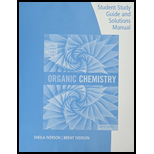
(a)
Interpretation:
The product of the aldol reaction of the given compound and the product formed from dehydration of the aldol product has to be drawn.
Concept introduction:
Aldol reaction is an addition reaction of
(b)
Interpretation:
The product of the aldol reaction of the given compound and the
Concept introduction:
Aldol reaction is an addition reaction of aldehydes and ketones. Aldol reaction is a reversible reaction and occurs in the presence of a strong base like sodium hydroxide. One molecule (aldehyde or ketone) acts a nucleophile and attacks the electrophilic carbon center of the other molecule to give the addition product. The product is named
(c)
Interpretation:
The product of the aldol reaction of the given compound and the
Concept introduction:
Aldol reaction is an addition reaction of aldehydes and ketones. Aldol reaction is a reversible reaction and occurs in the presence of a strong base like sodium hydroxide. One molecule (aldehyde or ketone) acts a nucleophile and attacks the electrophilic carbon center of the other molecule to give the addition product. The product is named
(d)
Interpretation:
The product of the aldol reaction of the given compound and the
Concept introduction:
Aldol reaction is an addition reaction of aldehydes and ketones. Aldol reaction is a reversible reaction and occurs in the presence of a strong base like sodium hydroxide. One molecule (aldehyde or ketone) acts a nucleophile and attacks the electrophilic carbon center of the other molecule to give the addition product. The product is named
Trending nowThis is a popular solution!

Chapter 19 Solutions
Student Study Guide and Solutions Manual for Brown/Iverson/Anslyn/Foote's Organic Chemistry, 8th Edition
- The following molecule can be formed via an intramolecular aldol addition reaction. Draw the organic starting material needed to form the given B-hydroxycarbonyl compound. organic starting material B-hydroxycarbonyl NaOH OHarrow_forwardDraw the products formed in each crossed aldol reaction.arrow_forwardDraw the Claisen product formed from each ester.arrow_forward
- What is the general name for the reaction product formed in an aldol addition reaction? O y-Hydroxy carbonyl compound a,B-Hydroxy carbonyl compound O a-Hydroxy carbonyl compound O B-Hydroxy carbonyl compoundarrow_forwardWhy is it not advisable to use aqueous hydrochloric acid in a Grignard reaction of a ketone? A) The Grignard reagent will react with the acid and cannot react with the ketone. B) The ketone will be protonated and will become unreactive. C) The ketone will form an unreactive enol. D) The Grignard reagent won't dissolve in aqueous solutionsarrow_forwardDraw the products of the complete hydrolysis of an acetal. Draw all products of the reaction.arrow_forward
- Drawing an Enol and a Ketone Formed by Hydration of an Alkyne Draw the enol intermediate and the ketone product formed in the following reaction.arrow_forward2 H3C H3C H C→XT OH H3C The aldol reaction is a carbonyl condensation reaction between two carbonyl partners and involves a combination of nucleophilic addition and a-substitution steps. One partner is converted into an enolate ion nucleophile and adds to the electrophilic carbonyl group of the second partner. In the classic aldol reaction, the carbonyl partners are aldehydes or ketones, although aldehydes are more reactive. The product is a ß-hydroxy carbonyl compound. base :0: OH H H Under reaction conditions slightly more vigorous than those employed for the aldol reaction, the ß-hydroxyl group is eliminated in an E1cB dehydration to give an a,ß-unsaturated carbonyl compound. Draw curved arrows to show the movement of electrons in this step of the mechanism. Arrow-pushing Instruct ns H3C heat OH H3C :0: H + H₂O Harrow_forwardDraw the complete mechanism for the acetal formation.arrow_forward
- The following molecule is formed in an intramolecular aldol condensation reaction. Draw the organic starting material needed to form the given α,β-unsaturated carbonyl compound.arrow_forwardIdentify the best reagents to complete the following reaction.arrow_forwardDraw the products of the complete hydrolysis of a ketal. Draw all products of the reaction. CHз Нас, CH2 + H. н -CH2 H2C CH3 CH2 СHзarrow_forward
 Organic Chemistry: A Guided InquiryChemistryISBN:9780618974122Author:Andrei StraumanisPublisher:Cengage Learning
Organic Chemistry: A Guided InquiryChemistryISBN:9780618974122Author:Andrei StraumanisPublisher:Cengage Learning
